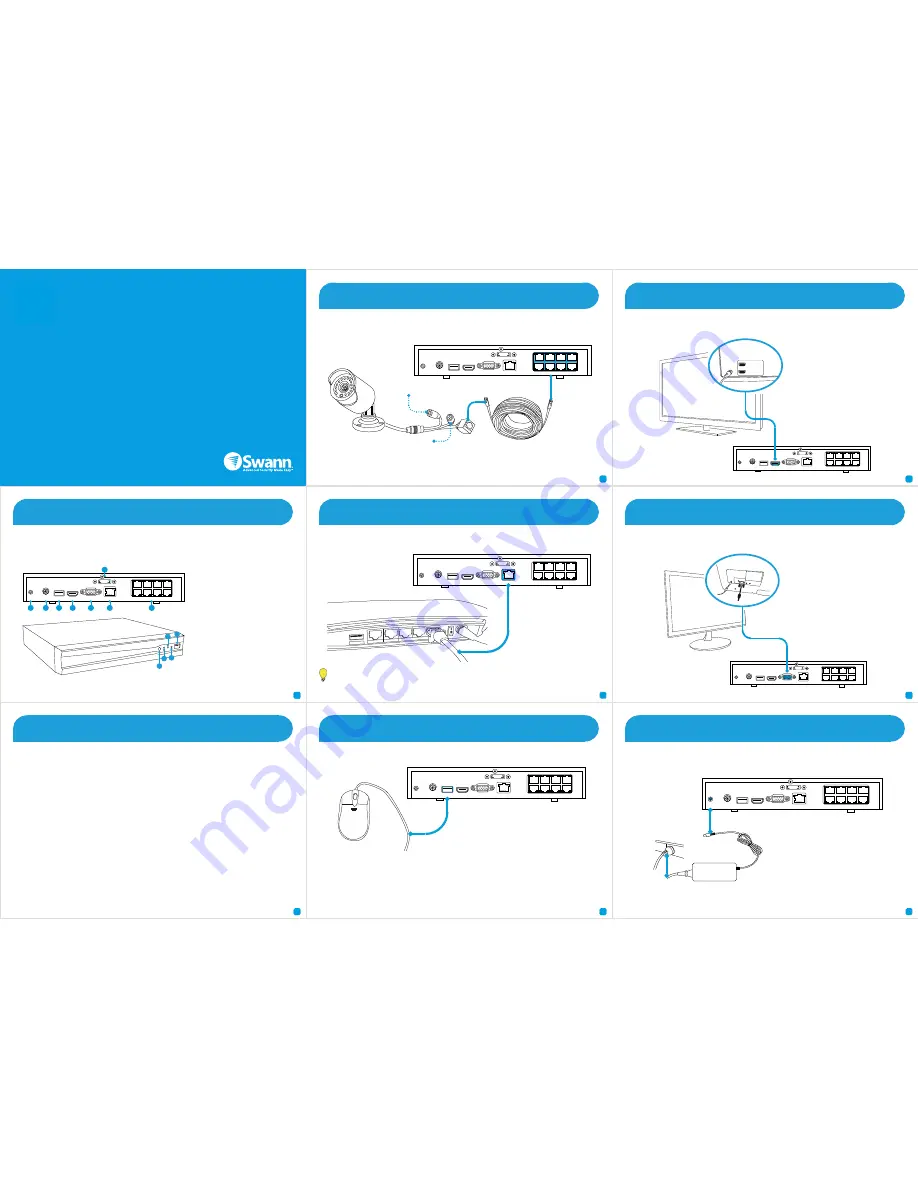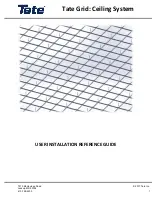
1
2
3
4
5
6
7
8
9
1
Network Video Recorder
Quick Start Guide
Welcome!
Lets get started.
To connect your camera(s) to the NVR, simply connect the supplied Ethernet cable to the LAN connection on the
camera then plug the other end of the Ethernet cable into one of the camera inputs on the back of the NVR.
Connect the mouse (supplied) to the USB port located at the rear of the NVR.
Connect the power adapter (supplied) to the power input on the NVR. Connect the power cable (supplied) to the power
adapter and plug the other end to a wall socket.
All connections have now been completed. You’re now ready to run through “The Setup Wizard” to configure your NVR.
QH_7300H291014E | © Swann 2014
If you have a Monitor with a VGA connection, connect a VGA cable (not supplied) to the VGA output on the NVR, and
connect the other end to the VGA input on the Monitor. You can skip this step if you are using the supplied HDMI cable.
Here are explanations for the various connections and
lights on the NVR -
1) Power
- This is where you connect the power adapter.
2) Audio Out
- For connecting speakers.
3) USB
- Connect the mouse here.
4) HDMI
- If you have a digital TV with HDMI input, connect
this to an available input.
5) VGA
- If you have a digital TV or a monitor with VGA
input, connect this to an available input.
6) eSATA
- An easy way to connect an additional Hard
Drive for extra storage.
7) LAN
- Connect this to your home network so your NVR
can connect to the Internet.
8) Camera Inputs
- Plug the camera cables here.
9) IR Receiver
- Receives a signal from the included
remote control.
10) Power LED
- When the NVR has power, this light will
turn on.
11) HDD LED
- This will flash when the hard drive is
working.
12) LAN LED
- This will flash when there is network activity.
13) USB
- Able to connect a Flash Drive to backup recorded
events or to perform firmware updates.
EN
Getting to know your NVR
Congratulations on the purchase of your Swann NVR. This quick start guide will assist you on getting your NVR up and
running as soon as possible. We recommend that you connect everything and give it a try before you do a permanent
installation, to make sure nothing was damaged during shipping. On the other side is a detailed connection map which
illustrates the various connections on the NVR.
1)
Power
2)
Audio Out
3)
USB
4)
HDMI
5)
VGA
6)
eSATA
7)
LAN
8)
Camera In-
puts
9
10
11
12
13
9)
IR Receiver
10)
Power LED
11)
HDD LED
12)
LAN LED
13)
USB
What does this mean?
Connecting the Cameras
Connect to your Home Network
Connect the Ethernet cable (supplied) to the LAN connection on the NVR, and then connect the other end to a spare
port on your router or wireless access point.
It’s important to do this as it allows the NVR to connect to the Internet to update its internal clock so the time it
shows on the video is always accurate, to send you email notifications and to access from your smartphone or
tablet.
Connect the Mouse
Connect the NVR to your HDTV
Connect the HDMI cable (supplied) to the HDMI input on the NVR, and connect the other end to a spare HDMI input on
the TV. Make sure your HDTV input matches the physical connection used to connect your NVR.
Connect the NVR to your Monitor (optional)
Connect the Power Adapters
2
3
4
6
7
8
AUDIO
OUT
eSATA
LAN
VGA
HDMI
DC 48V
USB
1
3
5
7
2
4
6
8
1
2
3
4
5
7
6
8
DC Power (optional)
Reset Button
AUDIO
OUT
eSATA
LAN
VGA
HDMI
DC 48V
USB
1
3
5
7
2
4
6
8
AUDIO
OUT
eSATA
LAN
VGA
HDMI
DC 48V
USB
1
3
5
7
2
4
6
8
USB
Internet
Ethernet
4
3
2
AUDIO
OUT
eSATA
LAN
VGA
HDMI
DC 48V
USB
1
3
5
7
2
4
6
8
It doesn’t really matter which port you use as they are quite versatile and will be configured in a later step. Please note;
the Ethernet cable is the same at both ends so it doesn’t matter which end plugs into the camera or NVR.
AUDIO
OUT
eSATA
LAN
VGA
HDMI
DC 48V
USB
1
3
5
7
2
4
6
8
HDMI IN 2
HDMI IN 1
AUDIO
OUT
eSATA
LAN
VGA
HDMI
DC 48V
USB
1
3
5
7
2
4
6
8
AUDIO
OUT
eSATA
LAN
VGA
HDMI
DC 48V
USB
1
3
5
7
2
4
6
8




















